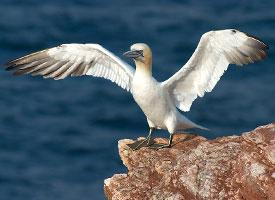
Description de l'animal
The Northern Gannet (Morus bassanus) is a majestic seabird, a spectacle of grace, agility, and beauty, predominantly dwelling in the North Atlantic. This species is the largest member of the gannet family, Sulidae, and is easily recognizable by its striking appearance and impressive wingspan.Adult Northern Gannets boast a length of about 87 to 100 centimeters (34 to 39 inches) and a wingspan that stretches approximately 170 to 180 centimeters (67 to 71 inches), making them a sight to behold as they glide over the ocean. Their bodies are predominantly white, with a stark contrast provided by black-tipped wings. A distinguishing feature is their head, which during the breeding season turns a stunning buff-yellow, adding to their allure. The bird's piercing blue eyes are surrounded by black skin, and its long, pointed beak is ideally shaped for diving, being strong, and tinted a bluish hue.
Northern Gannets are renowned for their spectacular feeding technique known as plunge diving. They can spot a school of fish from heights of 30 meters (about 100 feet) or more, folding their wings back as they dive into the water at speeds of up to 100 kilometers per hour (62 miles per hour). This breathtaking plunge not only showcases their hunting prowess but also their adaptation to a life spent mostly at sea. Once underwater, they use their powerful webbed feet to propel themselves, catching their prey with precision.
These birds are highly sociable during the breeding season, forming large, dense colonies on cliffs and islands. Notable breeding sites include the coasts of the United Kingdom, Ireland, and parts of Canada, among others. In these colonies, the Northern Gannet constructs its nest from seaweed, grass, and other marine debris, cementing the materials together with its own droppings to form a sturdy structure. A single pale blue egg is laid each breeding season, which both parents incubate and later, tirelessly feed the hatchling by regurgitating fish.
The Northern Gannet's life at sea is equally fascinating. Outside the breeding season, they can be found roaming vast distances across the North Atlantic, from the coasts of North America to the western coasts of Europe and down to the Gulf of Africa. Despite their extensive range, Northern Gannets are faithful to their breeding sites, often returning to the same spot year after year to reunite with their mate, as they are monogamous and form long-term pair bonds.
Conservation efforts have been critical in ensuring the survival of the Northern Gannet. While currently not classified as endangered, they face threats from oil spills, plastic pollution, and overfishing, which reduce their food sources. Protective measures and the monitoring of breeding colonies have been essential in maintaining stable population numbers.
In summary, the Northern Gannet is a remarkable bird, embodying the wild, untamed beauty of the oceanic world. Its life, from the dramatic plunges into the sea to the communal harmony of its breeding colonies, paints a vivid picture of adaptation and survival in the natural world.
Nouvelles photos d'animaux
Top 10 des animaux
- Common reed warbler (Acrocephalus scirpaceus)
- Diana monkey (Cercopithecus diana)
- Moustached guenon (Cercopithecus cephus)
- Galápagos tortoise (Geochelone nigra complex)
- Dolphin gull (Leucophaeus scoresbii)
- Hen harrier (Circus cyaneus)
- Brant (Branta bernicla)
- Stone loach (Barbatula barbatula)
- Common house mosquito (Culex pipiens)
- Colossal squid (Mesonychoteuthis hamiltoni)